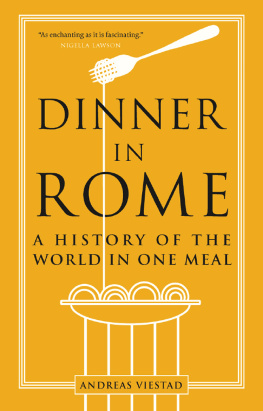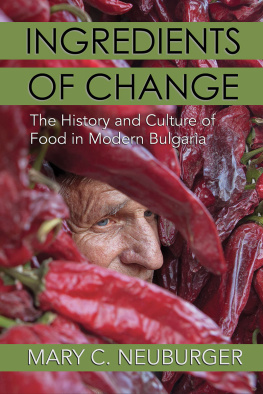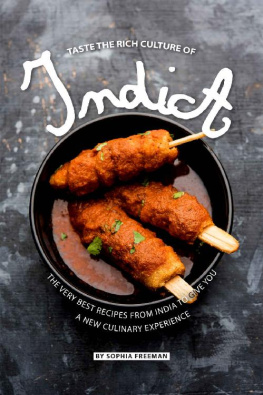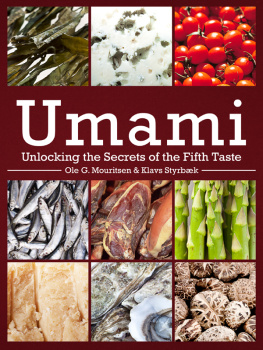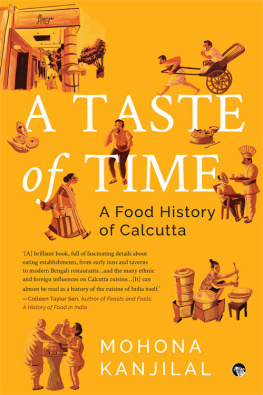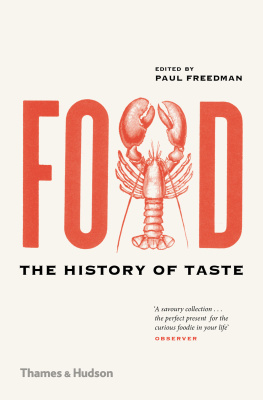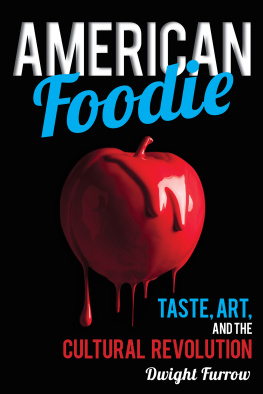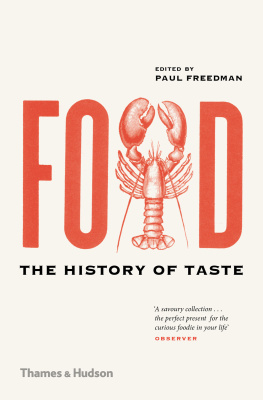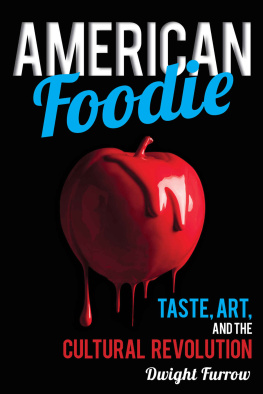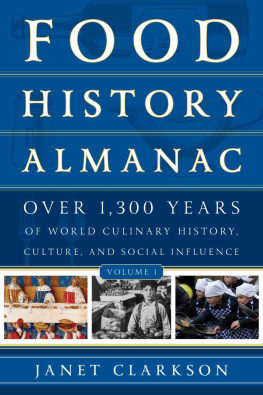





THIS EDITION FIRST PUBLISHED IN THE UNITED STATES IN 2017 BY
THE OVERLOOK PRESS, PETER MAYER PUBLISHERS, INC.
141 WOOSTER STREET, NEW YORK, NY 10012
WWW.OVERLOOKPRESS.COM
CATALOGUING IN PUBLICATION DATA
IS AVAILABLE FROM THE LIBRARY OF CONGRESS
ISBN 978 1 4683 1441 0
TEXT TOM NEALON 2016
IMAGES AND LAYOUT THE BRITISH LIBRARY BOARD
AND OTHER NAMED COPYRIGHT HOLDERS 2016
DESIGNED AND TYPESET BY
DANIEL STREAT, VISUAL FIELDS
PICTURE RESEARCH BY SALLY NICHOLLS
PRINTED AND BOUND IN CHINA BY
C&C OFFSET PRINTING CO., LTD
p. 4 | Une Confisseuse, Assemblage nouveau des manouvriers habilles (1735)
p. 5 | Un Cuisinier, Assemblage nouveau des manouvriers habilles (1735)
pp. 67 | Chillies (Piper Indicum), Basilius Besler, Hortus Eystettensis (1613)
pp. 89 | Knives and forks, Vincenzo Cervio, Il Trinciante (1593)
pp. 1011 | Dinner Table with Floral Decorations, Mrs Beeton, The Book of Household Management (1892)
p. 12 | Un Confisseur, Assemblage nouveau des manouvriers habilles (1735)
p. 13 | Une Cuisiniere, Assemblage nouveau des manouvriers habilles (1735)
p. 222 | Un Caffetier, Assemblage nouveau des manouvriers habilles (1735)
p. 216 | Un Pecheur, Assemblage nouveau des manouvriers habilles (1735)
p. 217 | Une Boulangre, Assemblage nouveau des manouvriers habilles (1735)
p. 218 | Balsamina Formina, Basilius Besler, Hortus Eystettensis (1613)
p. 223 | Les Rves dun Gourmand, frontispiece from Grimod, lAlmanach des Gourmands (1808)
p. 224 | Un Caffetier, Assemblage nouveau des manouvriers habilles (1735)


CONTENTS



INTRODUCTION
As fond as I am of eating, from the beginning it was the lies and artifice of food that grabbed me. About ten years ago, I had the idea to try to cook every food mentioned in Geoffrey Chaucers The Canterbury Tales (c. 1390). I think it arose from my interest in the scurrilous cook Roger, who would drain gravy out of pies to sell in the lucrative second-hand gravy market, but also that I had ended a run of bad restaurant jobs to open my used bookshop in Boston, Massachusetts, and I wanted to splice these two lives together. One of the first dishes that I cooked in preparation for my project was a thirteenth-century recipe for chicken, that was first taken off the bone, the bone cleaned and boiled, and, finally, the chicken rewrapped around the bone and fried in place to achieve chicken disguised to look like chicken.
Ive long had a dilettantes interest in the food of the Late Middle Ages that is, from around 1300 to 1500. The food of these times is so foreign to our own: turtledoves, mutton, flagons of mead, and pork fat, which seems to appear in every dish. The cuisine was loaded with experimental oddities from the spice trade, and in a constant state of flux. I cooked a weird proto-blancmange held together with rice starch and almond milk, and a mashed-up pork dish called mortorio, a recipe from a fourteenth-century manuscript. However, my attempts to find a peacock to skin, roast, and then present with the skin replaced so that it appeared as though I was serving a live, if motionless, peacock on a platter, were stymied by the fact that it is apparently illegal to kill peacocks. I tried Miami, where peacocks run free through residential neighbourhoods, but was unable to bring myself to choke one to death. After cooking and writing about dozens of dishes from early cookbooks, and holding a few memorably strange dinner parties, I began to nurse a more general interest in the history of food. As my business succumbed to the pressure of the Internet and became less about selling used paperbacks than finding old and rare books, I began to buy the best examples I could find, with the (vague) intention of issuing a catalogue of rare early cookbooks.

A Boke of Kokery (c. 1440). Held at the British Library, this is one of about fifty medieval recipe manuscripts still in existence. The first recipe, shown here, is for Hare in Wortes [Herbs].
Despite its central importance in our lives, the historical record of food is very patchy. In the ancient world there is just one cookbook that survived, from around the fourth century, and some rather random texts that describe banquets (the Ancient Greek Athenaeus The Learned Banqueters from the late-second century C.E., and a few other minor examples). During the Renaissance, between the fourteenth to seventeenth centuries, meals eaten by the European elite began to be recorded in cookbooks, but there are huge gaps in the accounts, even regarding what royalty was eating at the time. In the rise and fall of empires, the daily story of eating was very often neglected, even though discovery, exploitation, and speculation were so often food-related; as in colonial enterprises such as the spice trade, sugar plantations, and turkey-relocation programmes. A (very small) war was fought over the clove supply on Ambon Island in 1623, and while history records the war, there is no mention of why cloves, beyond their monetary value, were so beloved as to justify killing people. Diarists and historians such as Samuel Pepys (16331703) or John Evelyn (16201706) occasionally made valuable observations about what they and their contemporaries were eating, or about the opening of new restaurants, but even they give a very incomplete picture of what food was being eaten and what it meant to people. Food was everywhere and nowhere, lost in its own ubiquitous utility.
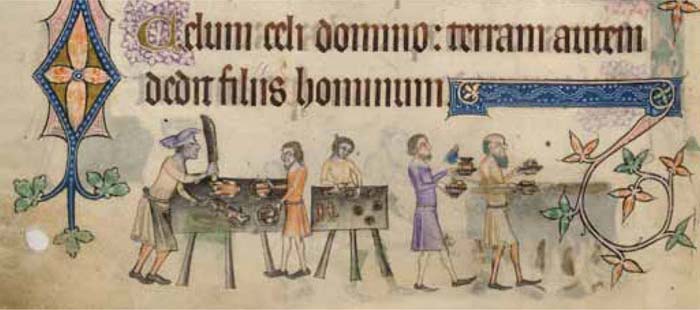
Preparing a banquet, from The Luttrell Psalter (132540).
As a result, fanciful stories sprang up to explain from where these new foods had come. The cooks usually had no idea of the truth and were fabricating origins long after the fact, and often with a surfeit of whimsy, so that these inventions are frequently described as delightful accidents: mayonnaise was invented to mimic thickened cream at a banquet; chocolate blew into a meat stew and created the Mexican dish
Next page

